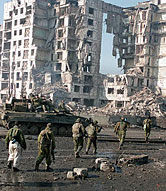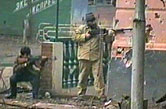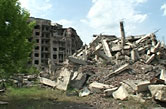By Thomas de Waal
July 25, 2002
Islamic fundamentalism in Chechnya is a much misunderstood problem. It exists — but only as a consequence of the war between Chechens and Moscow.
Both Russians and hard-line fighters have an interest in talking up the Islamic factor. The most radical Chechen guerrillas, in their propaganda material disseminated through the Web site kavkaz.org describe their fighters as “mujahadin” or “martyrs,” fighting a “jihad” or holy war against the Russian armed forces. That helps them raise money for weapons and supplies in mosques from London to Jeddah.
Russia points out that these radical fighters had a link to the Al Qaeda movement through a Saudi-born warrior of fortune known as Ibn ul-Khattab, who had fought in Afghanistan, and moved to Chechnya in 1995. Khattab, a professional “mujahadin” fighter who sported thick curly shoulder-length black hair, was reported murdered by poisoning in Chechnya in March.
It recently came to light that Ayman Al-Zawahri, Osama Bin Laden’s right-hand man spent six months in a Russian jail, after trying to infiltrate Chechnya in 1996. He was travelling under a false name and his cover was not blown. After his release, he settled in Afghanistan.
After September 11, Russia’s president Vladimir Putin was quick to use evidence like this to prove to the United States that he was an stalwart ally in the fight against “Islamic terror” — only, as he repeatedly pointed out, Russia had already been fighting the terrorists in Chechnya for years, not months.
This message succeeded in further softening Western criticism of Russia’s brutal military campaign. “Russia is fighting terrorists in Chechnya, there’s no question about that, and we understand that,” U.S. Secretary of State Colin Powell said in May. At the same time, the U.S. sent military trainers to Georgia, on the other side of the Caucasus mountains from Chechnya, to try to help the local security forces clean up the Pankisi Gorge region of Islamic militants.
And yet most of this is based on a big misunderstanding of what is really going on in Chechnya.
Proclaiming independence from Moscow in 1991, Chechnya’s first rebel president, Jokhar Dudayev, declared a secular state. Dudayev, a former Soviet general, was so ignorant about Islam that he once famously advised his citizens that, as good Muslims, they should pray three – and not five – times a day.
Dudayev’s cause was a nationalist one – freeing Chechnya, as he put it, from “two hundred years of persecution” by the Russian state. For him, the key date in Chechen history was Stalin’s mass deportation of the Chechen people to Central Asia in 1944. Dudayev frequently said he was ready to have close economic and political ties with Russia, so long as “historical justice” was restored to his people.
Islam began to be a factor only after Moscow’s first military intervention against Dudayev in December 1994. At the start of armed resistance to the Russians, many Chechens looked for inspiration to their history or to the war against the Russians in Afghanistan. Fighters, many of whom had been drinking vodka a few years before, wound green Islamic headbands around their heads and learned how to pray.
Lack of money also proved critical. When Khattab arrived in Chechnya in 1995, he brought promises of Saudi funding – and made grisly publicity videos of his attacks on Russian soldiers to entice potential funders in the Middle East. Yet Khattab was one of only perhaps a few dozen Arab fighters who came to fight in Chechnya.
In fact, most Chechens remained very suspicious of the incoming Middle East zealots, like Khattab, known as “Wahhabis” because of their allegiance to a particularly austere form of Sunni Islam. Most Chechen Muslims by contrast are adherents of the mystical Sufi form of Islam and pray at home rather than in the mosques. They visit shrines and say prayers at the tombs of their ancestors. The women do not wear veils. Local traditions tend to be stronger than Muslim observance. Even in the 1840s and 1850s, when the Islamic chieftain Imam Shamil led resistance to the Russian tsar’s armies in the region, he said that the Chechens were good warriors, but bad Muslims. He was unable to stop them smoking, playing music and dancing.
Proof that good guerrillas did not necessarily make good fundamentalists was in evidence in 1996, after the rebels had won their first military victory against the Russians. The separatists tried to introduce Islamic Sharia courts into Chechnya and order beatings for anyone convicted of drinking or drug abuse. Yet one high-profile Sharia judge turned out, when interviewed, to be an almost comic bundle of contradictions. Jumbalat Samkhatov was a former soccer player, who said he took his duties very seriously and admired the Taliban. He was also a typical Chechen, hazy about Islamic doctrine, laughing, chain-smoking Marlboros and flirting with a woman photographer colleague.
Samkhatov was the rule, not the exception. Apart from a few high-profile cases, Sharia justice never caught on in Chechnya. To settle their disputes Chechens continued to use their tried and traditional methods – the verdict of respected elders or the firearms of young men.
The two strains in Chechnya of support and opposition for radical Islam diverged so strongly that armed supporters of Dudayev’s successor as rebel president, Aslan Maskhadov, fought a small civil war with fundamentalist Chechens in 1998.
The second Russian military intervention in October 1999 and thousands more civilian casualties have radicalised Chechnya again and inevitably made Islamic fundamentalism more attractive to young Chechens. Yet this war’s links to the “war on terror” remain oblique and confusing. If the Arab volunteers in Chechnya went home and all foreign funding for the rebels ceased, radical Islam would again fade as a factor in the conflict. But the deep underlying – and overwhelmingly political – problems that divide most ordinary Chechens from Russia would still remain.
Thomas de Waal, is a London-based journalist, who writes on Russia and the Caucasus. He is co-author, with Carlotta Gall, of “Chechnya: Calamity in the Caucasus,” (New York University Press, 1998). He is currently Caucasus Editor with the Institute for War and Peace Reporting, www.iwpr.net, in London.



